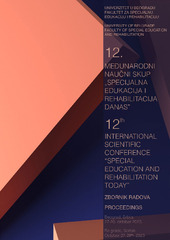Приказ основних података о документу
Neophodnost primene кontrolnog merenja u terapiji osoba sa povredom mozga
The necessity of application of control measurement in therapy of persons with brain injury
| dc.creator | Rapaić, Dragan | |
| dc.creator | Marinković, Dragan | |
| dc.creator | Aleksić, Vuk | |
| dc.creator | Aleksić, Nemanja | |
| dc.creator | Babović, Rade | |
| dc.date.accessioned | 2024-01-11T12:23:05Z | |
| dc.date.available | 2024-01-11T12:23:05Z | |
| dc.date.issued | 2023 | |
| dc.identifier.isbn | 978-86-6203-174-7 | |
| dc.identifier.uri | http://rfasper.fasper.bg.ac.rs/handle/123456789/5378 | |
| dc.description.abstract | Uvod: Kontrolno merenje je uobičajeno u eksperimentalnim situacijama, dok se u praksi često ne realizuje ili se obavi razgovor sa pacijentom. Očigledno je da moramo da postavimo pitanja poput: da li je uopšte potrebno vršiti kontrolno merenje, kada se ono vrši, kojim instrumentima i koliko kontrolnih merenja je potrebno izvršiti? Ova pitanja duboko zadiru u doktrinu bilo koje nauke i prakse. Cilj: U ovom radu razmatra se eventualna neophodnost primene kontrolnih merenja sa teorijskog i praktičnog aspekta. Metode: U radu smo se bavili terapijom kognitivnih i motoričkih funkcija kod osoba sa povredom mozga, odnosno fenomenima pamćenja, pažnje, orijentacije i praksičkim funkcijama. Uzorak je činilo 15 muških i ženskih ispitanika starosti od 15 do 20 godina. Kognitivne i praksičke funkcije ispitivali smo subtestovima The Mental Status in Neurology (Stub, Block, 1983) i Cognitive Asseasment Abillity (Adamovich, Henderson, Auerbach, 1985). Izbor subtestova je u ovom slučaju bio orijentisan ka stečenim znanjima, iskustvima, poluapstraktnom i apstraktnom mišljenju. Nakon eksperimentalnog tretmana koji je trajao četiri nedelje, izvršili smo kontrolno merenje. Rezultati: Dobijeni rezultati pokazuju opravdanost primene kontrolnog merenja kod testiranih ispitanika. Oni ukazuju na značaj kontrolnog merenja, koji se ogleda u mogućnost evidentiranja napretka tretiranih pacijenta u ispitivanim domenima. Kontrolnim merenjem, dakle, možemo utvrditi napredak ili zastoj u oporavku pojedinih delova ispitivanih i tretiranih funkcija. Rezultati istraživanja nedvosmisleno ukazuju na statistički značajnu razliku (od p<0,5 do p<0,1) između prvog i drugog merenja u ispitivanim funkcijama. Zaključak: Na osnovu dobijenih rezultata možemo zaključiti da je kontrolno merenje neophodan pristup u potvrdi značaja primene aktuelnih terapijskih postupaka, njihovoj modifikaciji i doziranju. | sr |
| dc.description.abstract | Introduction: Control measurement is common in experimental situations, while in practice, it is often overlooked or just reduced to a conversation with the patient. It is obvious that we have to ask questions such as: is it necessary to perform a control measurement at all, when is it performed, with which instruments and how many control measurements should be performed? These questions go deep into the doctrine of any science and practice. Aim: In this paper, the eventual necessity of performing control measurements is considered from the theoretical and practical aspects. Methods: In this work, we dealt with the therapy of cognitive and motor functions, that is, the phenomena of memory, attention, orientation, and practical functions. The sample consisted of 15 male and female respondents aged 15 to 20 years. We examined their cognitive and practical functioning using subtests from The Mental Status in Neurology (Stub, Block, 1983) and Cognitive Assessment Ability (Adamovich, Henderson, Auerbach, 1985). The choice of subtests was oriented towards acquired knowledge, experiences, semi-abstract and abstract thinking from the patient’s immediate environment. Upon application of the experimental model, which lasted four weeks, we performed a control measurement. Results: The obtained results show the justification of the application of the control measurement in the tested subjects. The results indicate the importance of control measurement, which is reflected in the possibility of recording the progress of treated patients in the examined domains. By control measurement, therefore, we can determine progress or stagnation in the recovery of certain parts of the tested and treated functions. The research results unequivocally indicate a statistically significant difference (p<0.5 to p<0.1) between the first and second measurements in the examined functions. Conclusion: Based on the obtained results, we can conclude that control measurement is a necessary approach in confirming the correctness of using current therapeutic procedures, their modification, and dosage. | sr |
| dc.language.iso | sr | sr |
| dc.publisher | Univerzitet u Beogradu – Fakultet za specijalnu edukaciju i rehabilitaciju University of Belgrade – Faculty of Special Education and Rehabilitation | sr |
| dc.relation | Rad je proistekao iz projekata: „Kliničko forenzička istraživanja povreda – Povrede glave i restorativna neurologija”, čiju je realizaciju podržalo Ministarstvo nauke, tehnološkog razvoja i inovacija Republike Srbije (1996–2000. Projekat br. 13M22) i „Ispitivanja molekularno-genetskih, patohistoloških i biohemijskih karakteristika neuromišićnih bolesti” čiju je realizaciju podržalo Ministarstvo nauke, tehnološkog razvoja i inovacija Republike Srbije (Projekat br. 175083). | sr |
| dc.rights | openAccess | sr |
| dc.rights.uri | https://creativecommons.org/licenses/by-sa/4.0/ | |
| dc.source | Zbornik radova - 12. Međunarodni naučni skup Specijalna edukacija i rehabilitacija danas Beograd, 27–28. oktobar 2023. Godine | sr |
| dc.subject | kontrolno merenje | sr |
| dc.subject | povrede mozga | sr |
| dc.subject | terapija | sr |
| dc.subject | testiranje | sr |
| dc.subject | control measurement | sr |
| dc.subject | brain injury | sr |
| dc.subject | therapy | sr |
| dc.subject | testing | sr |
| dc.title | Neophodnost primene кontrolnog merenja u terapiji osoba sa povredom mozga | sr |
| dc.title | The necessity of application of control measurement in therapy of persons with brain injury | sr |
| dc.type | conferenceObject | sr |
| dc.rights.license | BY-SA | sr |
| dc.citation.epage | 555 | |
| dc.citation.spage | 549 | |
| dc.identifier.fulltext | http://rfasper.fasper.bg.ac.rs/bitstream/id/10989/Untitled35.pdf | |
| dc.identifier.rcub | https://hdl.handle.net/21.15107/rcub_rfasper_5378 | |
| dc.type.version | publishedVersion | sr |


